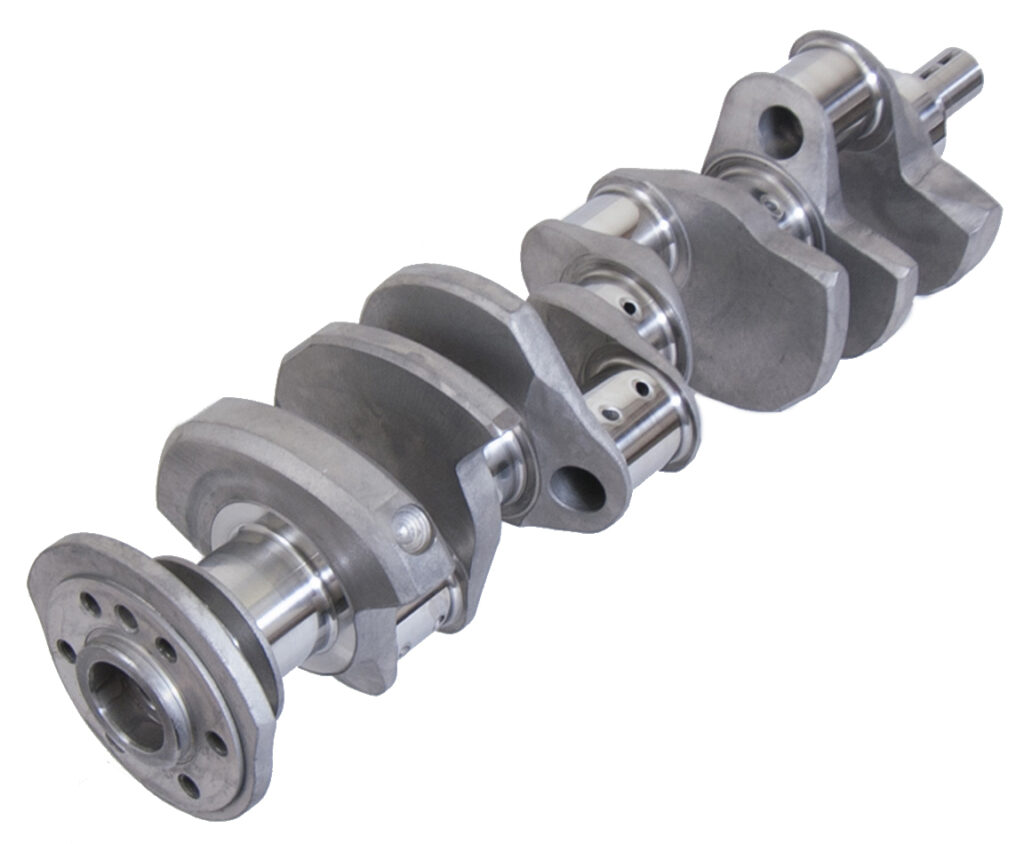The supply of suitable junkyard crankshaft cores, once a mainstay of racers everywhere, has pretty much dried up, but performance enthusiasts now have many sources for new, reasonably priced cranks for Chevrolets as well as popular Ford and Chrysler engines.
One of the first things beginning engine builders often ask is: what is the best crank to use, forged or cast? A cast crank is just that; an iron casting in which the metallurgical structure is made up of a random pattern of molecules, full of microscopic holes and voids. A forged steel crank is manufactured by compressing a much purer metal into the die under extreme heat and pressure to create a very dense molecular structure… and a much stronger crank.

It’s relatively easy to spot the difference between a cast crank and a forged one. Cast units have a distinct parting line located on each of the counterweights and throws while forged units can be identified by a wide, raised die mark on the throws. The only weakness of a traditional standard forging is that during the manufacturing process, the connecting rod throws are offset by twisting the crankshaft. Twisting not only distorts and stresses the forging, but also restricts the types of metal that can be used.
Once the type of crank has been determined, there are several machine shop operations that can be performed to make it more durable, and to verify that the crank selected is suitable, especially for racing use.
Magnafluxing is an important step in the crank production and selection process. It is a dry, non-destructive test in which the part is subjected to a strong magnetic field while magnetic particles are sprinkled on the surface. Any cracks act as magnetic poles, causing the particles to line up along that point. Any cracks other than small stress cracks surrounding the oil holes are grounds for rejection.
Magnaglow is a wet, non-destructive test during which the part is coated with a liquid containing magnetic particles. The part is then subjected to a strong magnetic field which causes the particles to line up along any cracks that may exist. An ultraviolet light is used to locate the particles and the cracks.
Turning, or grinding, involves machining the journals undersize to repair scored or damaged bearing surfaces. Use of an undersized unit is of no concern and as long as the crank has been turned correctly, it will retain the proper oil clearances. Some racers will purposely “turn” a crank as much as .030″ or .040″ undersize in pursuit of a smaller bearing diameter that allows them to squeeze out a few more “horses”. A common practice involves machining the rod journals of a small block Chevy crankshaft down to 1.888″ so that smaller Honda-sized rod bearings may be used to maximize performance.
Indexing ensures that the rod throws are exactly 90° apart. Stroke checking is performed to see that each rod throw has the same stroke and can also be corrected during the indexing process. Offset grinding is a common practice employed by NHRA Stock and Super Stock racers to increase performance while staying within the NHRA’s +.015″ maximum allowable stroke tolerances. The journals are simply turned offset, typically .013″, to add a couple more cubic inches, yet while still meeting the sanctioning bodies’ strict rules.
Micropolishing creates a mirror-like finish on the bearing journal surface and it can also correct a crank- shaft that has very small nicks or imperfections.
Straightening involves placing the crank in a special fixture, pre-loading it with a hydraulic jack, and carefully striking it with a heavy hammer.
Cross Drilling involves drilling two intersecting holes at right angles through the main bearing journals so the rod journals receive “full-time” oiling, particularly helpful when used with standard half-grooved main bearings. Most OEM crankshafts have a single oil feed hole from the main to rod journals, sufficient for the daily driver, but not for a high-revving race engine.
Chamfering can be performed in the home garage with a small hand-held grinder. Oil passages drilled at the factory are often plagued with sharp edges left by tooling. By gently deburring and radiusing these holes with a small grinding stone, a small depression is created to act as a reservoir to help distribute oil across the surface of the journal.
Deburring removes sharp edges, or “stress risers”, which can transform into a crack. Use an abrasive wheel to quickly smooth over parting lines and die marks.
Shotpeening, similar to sandblasting, bombards the crankshaft with tiny ball bearings. The surface of the metal is compressed during the process, helping to prevent cracks from developing.
Stress Relieving “relaxes” the steel and involves heating the crankshaft to a specific temperature to allow the molecules to rearrange themselves. It then becomes “relaxed”, similar to the “seasoning” process that an engine block goes through as it accumulates miles.
Hard Chroming is a repair technique that also improves durability. A layer of chrome is built up to restore a damaged journal.
Tufftriding or Nitriding improves the surface hardness of the bearing journals. The crank is heated to 800°F and then dunked in a bath of cyanide salt. This process ideally penetrates the journals about .020″, but the results are sometimes inconsistent.